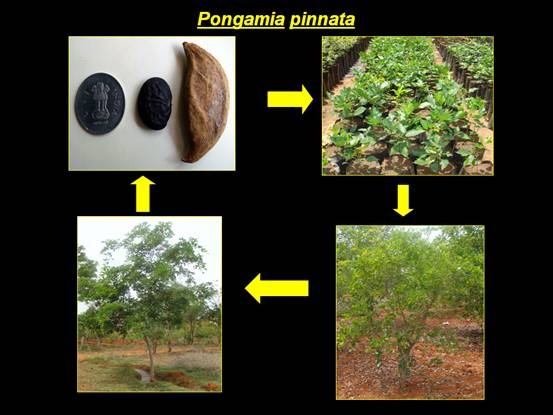
|
||
| Home | About Forestry | Eco-Tourism | Forestry Addresses | FAQs | Contact Us | Disclaimer | |
||
| Industrial Forestry | ||
BIOFUEL SPECIES
Scientific name: Pogamia pinnata Origin: It is native to humid and subtropical environments along the coasts and river Distribution: India and Myanmar. This species has been introduced to humid tropical low land in the Philipines, Malaysia, Australia, United States and Indonesia. Rotation: Grown in 30 years rotations for fuel wood Spacing: 2 x3 m (or) 3x3 m for block planting 6 x 8 m for avenue planting and on field borders. Nursery: Pungam is easily propagated by seeds and stem cutting. Seed is dibbled in the nursery beds any time after collection preferably in the beginning of hot weather, at a spacing of 7.5 cm x 15 cm. Mulching of sown beds is helpful. Germination commences after about 10 days and completed in about a month. Pricking out improves the growth. Seedlings attain a height of 25-30 cm by the end of first growing season and / or about 60 cm by the beginning of the next rainy season, when they may be planted out entire, with ball of earth, or in the form of stumps. The stem cuttings of 20-30 cm long and 2-4 cm in diameter are prepared in the month of November to February when plants become leafless. Cuttings are planted in the month of November to February at 60 x 30 cm distances. Planting: Seedlings of about 60 cm in height are suitable for planting with ball of earth, or in the form of root and shoot cuttings, in pits 45-60 cm3. Young plants should be provided with sufficient soil moisture by occasional watering for atleast two seasons. Plant Protection: Karanj plants may be attacked by defoliators, leaf miners and sapsuckers. Besides fungi like Ganoderma lucidum (root rot) and Fomes merillii attacks the seedlings and trees. Special Features: Nodulation capacity and biodiesel property of the oil. Tending: Two (or) three weedings are required per year for the first 2-3 years of sowing / planting. For the avenue trees, side branches should be pruned to get proper bole Yield and Economics: Trees often reach height in 4 - 5 years, bearing at age of 4-7 years. A single tree is said to yield 9-90 kg seed per tree, indicating a yield potential of 900-9000 kg seed/ha, and seed contain oil around 25%. In general, Indian mills extract 24 -27.5% oil and village crushers, 18-22% oil. Uses: It is a nitrogen-fixing, fodder and important tree borne oil seed of the leguminous family and also used as timber, fire wood, fodder, fibre, Manure, Food, Pest control, Poultry feed, Folk medicine. |
||
| Home | About Forestry | Eco-Tourism | Forestry Addresses | FAQs | Contact Us | Disclaimer |
© All Rights Reserved. TNAU-2016 |
||
